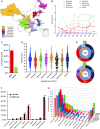Epidemiological updates of post-traumatic related limb osteomyelitis in china: a 10 years multicentre cohort study
- PMID: 37247014
- PMCID: PMC10498838
- DOI: 10.1097/JS9.0000000000000502
Epidemiological updates of post-traumatic related limb osteomyelitis in china: a 10 years multicentre cohort study
Abstract
Background: Post-traumatic related limb osteomyelitis (PTRLO) is a complex bone infection. Currently, there are no available microbial data on a national scale that can guide appropriate antibiotic selection, and explore the dynamic changes in dominant pathogens over time. This study aimed to conduct a comprehensive epidemiological analysis of PTRLO in China.
Methods: The study was approved by the Institutional Research Board (IRB), and 3526 PTRLO patients were identified from 212 394 traumatic limb fracture patients at 21 hospitals between 1 January 2008 and 31 December 2017. A retrospective analysis was conducted to investigate the epidemiology of PTRLO, including changes in infection rate (IR), pathogens, infection risk factors and antibiotic resistance and sensitivity.
Results: The IR of PTRLO increased gradually from 0.93 to 2.16% (Z=14.392, P <0.001). Monomicrobial infection (82.6%) was significantly higher than polymicrobial infection (17.4%) ( P <0.001). The IR of Gram-positive (GP) and Gram-negative (GN) pathogens showed a significant increase from the lowest 0.41% to the highest 1.15% (GP) or 1.62% (GN), respectively. However, the longitudinal trend of GP vs. GN's composition did not show any significance (Z=±1.1918, P >0.05). The most prevalent GP strains were Methicillin-sensitive Staphylococcus aureus (MSSA) (17.03%), Methicillin-resistant Staphylococcus aureus (MRSA) (10.46%), E. faecalis (5.19%) and S. epidermidis (4.87%). In contrast, the dominant strains GN strains were Pseudomonas Aeruginosa (10.92%), E. cloacae (10.34%), E. coli (9.47%), Acinetobacter Baumannii (7.92%) and Klebsiella Pneumoniae (3.33%). In general, the high-risk factors for polymicrobial infection include opened-fracture (odds ratio, 2.223), hypoproteinemia (odds ratio, 2.328), and multiple fractures (odds ratio, 1.465). It is important to note that the antibiotics resistance and sensitivity analysis of the pathogens may be influenced by complications or comorbidities.
Conclusions: This study provides the latest data of PTRLO in China and offers trustworthy guidelines for clinical practice. (China Clinical Trials.gov number, ChiCTR1800017597).
Copyright © 2023 The Author(s). Published by Wolters Kluwer Health, Inc.
Conflict of interest statement
The authors have no conflict of interest to declare.
Sponsorships or competing interests that may be relevant to content are disclosed at the end of this article
Figures




References
-
- Moriarty TF, Metsemakers WJ, Morgenstern M, et al. . Fracture-related infection. Nat Rev Dis Primers 2022;8:67. - PubMed
-
- Metsemakers WJ, Morgenstern M, McNally MA, et al. . Fracture-related infection: a consensus on definition from an international expert group. Injury 2018;49:505–10. - PubMed
-
- Schmitt SK. Osteomyelitis. Infect Dis Clin North Am 2017;31:325–38. - PubMed
-
- Jiang N, Wu HT, Lin QR, et al. . Health care costs of post-traumatic osteomyelitis in China: current situation and influencing factors. J Surg Res 2020;247:356–63. - PubMed
-
- Lew DP, Waldvogel FA. Osteomyelitis. Lancet 2004;364:369–379. - PubMed
Publication types
MeSH terms
Substances
LinkOut - more resources
Full Text Sources
Medical

